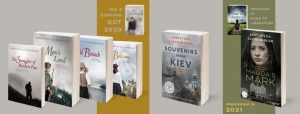Seven Essential Writing Exercises
 Rich Characters and Dialogues that Drive the Story: 7 Practical Exercises to Avoid Falling Flat
Rich Characters and Dialogues that Drive the Story: 7 Practical Exercises to Avoid Falling Flat
By Chrystyna Lucyk-Berger
I will never forget sitting in that room full of grad students in a creative writing class at the University of Minnesota, My short story was coming up for critique. Here was the problem: I was a misfit. I didn’t belong to this world of well-read, philosophical, bohemian beatniks. I was still doing my Bachelor of Science degree, hoping to become a veterinarian because my grandmother had told me that a writer is not a job, it’s a hobby, and if I wanted to be a writer, I was going to have to marry a doctor or a lawyer.
I was going to show her. I was going to be the doctor. Except that my compositions professor – a prerequisite I put off til my junior year – said I should try applying to the master’s program for creative writing. He threw a monkey-wrench into all my plans.
We were a group of 12 plus the professor and I had not won any friends mostly because they all terrified me. It began with our proposals for a reading list. Whereas the other students proposed Toni Morrison or Gabriel Garcia Marquez, neither of whom I’d ever heard of, I rated my favorite novel to be Stephen King’s Stand by Me.
The looks! But the professor put it on the list! In the first story critiques, I sat quiet until the professor threatened to throw me out if I did not open up and engage, tell the group what I “really thought” about their manuscripts. In despair, I admitted I hadn’t understood a darned thing I’d read. “He (the author) is trying too hard. It’s so experimental, there’s no story left.” And she – the professor – agreed!
It was really no wonder then that, on the day my story was up for critique, I felt ill. I had handed in a coming-of-age story, about a 12-year-old girl. The scene opened with the single mother in the kitchen, her daughter waking up and coming down to breakfast. The mother had run out of coffee so she was heating up a can of Diet Coke in a pot. The dialogue between mother and daughter began with “good-mornings” and turned to setting a shopping date to buy the girl’s first bra. … End of scene.
You can imagine how that went over with this crowd.
But there were acts of kindness that day. Some said they’d warmed up to the protagonists and had remembered the humiliation of puberty. One found the Diet Coke very funny, and had even tested it out. But one student interjected (I believe it was Mr Experimental). “I felt the characters and the dialogue were as flat as a 12-year-old’s chest.”
Gone was all the other praise I’d heard. That one critique rang in my ears for decades to come. I had also come to the conclusion shortly before that I was not cut out for medicine and had placed my hopes on reading and writing for the rest of my life. I collected the 12 manuscripts with the thousand red marks and slunk out of the classroom. The next step was to revise.
At home, I put those 12 manuscripts in a circle in front of me and, because it was obvious this group knew what they were talking about, I incorporated every single change without question. The next week, I handed it in.
My professor rang me a few days later and asked me to come see her. I was terrified. I should’ve written something more important. She was going to fail me. But when I arrived, she was welcoming, indicated a chair, and I sat down. Behind her, on a bookshelf, was a row of books, all with the same spines.
That woman set me straight. She told me to stop listening to everyone else all the time. To find and develop my own voice, grow confident in my own story. “You have talent and if you commit to the craft, you’re going to be the kind of writer who won’t have a bunch of her books on a bookshelf she can’t sell. You’ll be the kind of writer who might very well earn a living writing. And to be honest,” she pointed to her door, “that’s what they all want even if they think the word ‘commercial’ is a swear word.”
Before I could skip out of her office though, she reminded me, “That dialogue was flat. And your characters, too, but only on the page. Not in your head. Take your time and study the craft. Close that gap between head and page.”
I never became a veterinarian. I didn’t have the money to do a master’s degree, either. I dabbled in journalism convinced it was an honorable way to combine writing and a living. Fast forward 25 years, and I finally returned to creative writing. Those words, “Your dialogue is as flat as a 12-year-old’s chest” still rang in my memory. They drove me to learn and to never stop learning.
Over the years, I picked up a number of exercises that have helped me to build rich settings, dynamic dialogue that drives the story, and characters that are as multi-dimensional as any human being you know well. Those are probably the most consistent comments I get from reviewers of my books.
These practical exercises will help you get there, too. The first four are stream-of-consciousness exercises. You should spend 15-20 minutes on each, and can adapt them in any way you see fit. But try working within the framework before attempting to break out of it; it’s the times we are most uncomfortable that we truly learn something.
- Take any book off the shelf, open it to a random page, take a random line and imagine one of your characters in your story or novel has just said or done that. Write from there.
- Write about a character’s shoes. Where did he/she buy them? Why? Where have they been with them? Where did the scuff marks come from? What imprints do the soles leave? How deep?
- Write about your character through the perspective of a minor character in your book or story. Alternatively, have the character’s parent(s) sitting with friends (or foes) and talking about their child. What would they say?
- Imagine any enclosure or vessel – a box, a desk drawer, a chest of drawers, a wardrobe, a room – and have your character discover what’s inside. Alternatively, find out what meaning the objects in a room have for your character.
More controlled exercises: Take 15-20 minutes but you’ll need to work hard here.
- Write a scene with your character in it using all the senses but the visual. Focus on taste, sound, smell, touch and even instincts but do not allow yourself to describe anything visually.
- In the next scene of your book or story where two or more characters are involved, write it out using ONLY dialogue. How can you drive the story forward only through what the people say…and how they say it? (It’s like writing a play with no stage directions.)
- Research your character’s name and focus only on the name. What descriptions, characteristics, and stories come from just the name?
Then what? If you read the first books in my Reschen Valley series, you will recognize the results of these exercises in various passages. I almost always build them in. They lend depth, they lend meaning to the relationships, and they create rich, vibrant and three-dimensional characters – even the flat-chested ones.
—
 Chrystyna Lucyk-Berger is an American ex-pat living in the Alps of Austria. She writes award-winning historical fiction and short stories. The Reschen Valley series explores the complex relationships between a South Tyrolean woman, the Italian veteran whose life she saved and who is responsible for a plan to flood out her valley, and the community struggling to hang onto their land. Souvenirs from Kiev: Ukraine and Ukrainians in WW2 – A Collection of Short Stories, tied for the silver medal in the 2020 IPPY awards. Chrystyna lives in an alpine hut with her heroic (and loyal) husband, cantankerous (and loyal) cat, and adorable (and loyal) dog.
Chrystyna Lucyk-Berger is an American ex-pat living in the Alps of Austria. She writes award-winning historical fiction and short stories. The Reschen Valley series explores the complex relationships between a South Tyrolean woman, the Italian veteran whose life she saved and who is responsible for a plan to flood out her valley, and the community struggling to hang onto their land. Souvenirs from Kiev: Ukraine and Ukrainians in WW2 – A Collection of Short Stories, tied for the silver medal in the 2020 IPPY awards. Chrystyna lives in an alpine hut with her heroic (and loyal) husband, cantankerous (and loyal) cat, and adorable (and loyal) dog.
Find out more about her on her website https://www.inktreks.com/
Latest release:
Amid the chaos of war, can a scarred Czech woman put aside her plans for revenge and perform a much greater act of courage?
Magda’s Mark, featured in the six-novel compilation The Road to Liberation, released May 5th. books2read.com/RoadtoLiberation
Category: On Writing


























Brilliant exercises. I can use these! Thanks.
Excellent article.